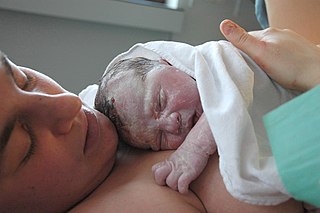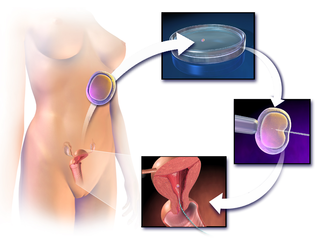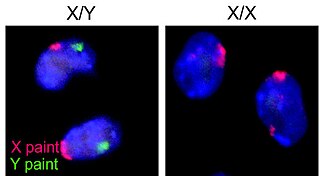Related Research Articles

In vitro fertilisation (IVF) is a process of fertilisation where an egg is combined with sperm in vitro. The process involves monitoring and stimulating a woman’s ovulatory process, removing an ovum or ova from their ovaries and letting a man’s sperm fertilise them in a culture medium in a laboratory. After the fertilised egg (zygote) undergoes embryo culture for 2–6 days, it is transferred by catheter into the uterus, with the intention of establishing a successful pregnancy.

Twins are two offspring produced by the same pregnancy. Twins can be either monozygotic ('identical'), meaning that they develop from one zygote, which splits and forms two embryos, or dizygotic, meaning that each twin develops from a separate egg and each egg is fertilized by its own sperm cell. Since identical twins develop from one zygote, they will share the same sex, while fraternal twins may or may not. In very rare cases twins can have the same mother and different fathers.

A multiple birth is the culmination of one multiple pregnancy, where in the mother gives birth to two or more babies. A term most applicable to vertebrate species, multiple births occur in most kinds of mammals, with varying frequencies. Such births are often named according to the number of offspring, as in twins and triplets. In non-humans, the whole group may also be referred to as a litter, and multiple births may be more common than single births. Multiple births in humans are the exception and can be exceptionally rare in the largest mammals.

Birth is the act or process of bearing or bringing forth offspring, also referred to in technical contexts as parturition. In mammals, the process is initiated by hormones which cause the muscular walls of the uterus to contract, expelling the fetus at a developmental stage when it is ready to feed and breathe.

The menstrual cycle is a series of natural changes in hormone production and the structures of the uterus and ovaries of the female reproductive system that makes pregnancy possible. The ovarian cycle controls the production and release of eggs and the cyclic release of estrogen and progesterone. The uterine cycle governs the preparation and maintenance of the lining of the uterus (womb) to receive an embryo. These cycles are concurrent and coordinated, normally last between 21 and 35 days, with a median length of 28 days, and continue for about 30–45 years.

In human reproduction, a live birth occurs when a fetus exits the mother showing any definite sign of life such as voluntary movement, heartbeat, or pulsation of the umbilical cord, for however brief a time and regardless of whether the umbilical cord or placenta are intact. After the fetus is expelled from the maternal body it is called a neonate. Whether the birth is vaginal or by caesarean section, and whether the neonate is ultimately viable, is irrelevant.
Fertility is the ability to conceive a child. The fertility rate is the average number of children born during an individual's lifetime and is quantified demographically. Conversely, infertility is the difficulty or inability to reproduce naturally. In general, infertility is defined as not being able to conceive a child after one year of unprotected sex. Infertility is widespread, with fertility specialists available all over the world to assist parents and couples who experience difficulties conceiving a baby.

Obstetric ultrasonography, or prenatal ultrasound, is the use of medical ultrasonography in pregnancy, in which sound waves are used to create real-time visual images of the developing embryo or fetus in the uterus (womb). The procedure is a standard part of prenatal care in many countries, as it can provide a variety of information about the health of the mother, the timing and progress of the pregnancy, and the health and development of the embryo or fetus.

The female reproductive system is made up of the internal and external sex organs that function in the reproduction of new offspring. The human female reproductive system is immature at birth and develops to maturity at puberty to be able to produce gametes, and to carry a fetus to full term. The internal sex organs are the vagina, uterus, fallopian tubes, and ovaries. The female reproductive tract includes the vagina, uterus, and fallopian tubes and is prone to infections. The vagina allows for sexual intercourse and childbirth, and is connected to the uterus at the cervix. The uterus or womb accommodates the embryo, which develops into the fetus. The uterus also produces secretions, which help the transit of sperm to the fallopian tubes, where sperm fertilize ova produced by the ovaries. The external sex organs are also known as the genitals and these are the organs of the vulva including the labia, clitoris, and vaginal opening.

Assisted reproductive technology (ART) includes medical procedures used primarily to address infertility. This subject involves procedures such as in vitro fertilization (IVF), intracytoplasmic sperm injection (ICSI), cryopreservation of gametes or embryos, and/or the use of fertility medication. When used to address infertility, ART may also be referred to as fertility treatment. ART mainly belongs to the field of reproductive endocrinology and infertility. Some forms of ART may be used with regard to fertile couples for genetic purpose. ART may also be used in surrogacy arrangements, although not all surrogacy arrangements involve ART. The existence of sterility will not always require ART to be the first option to consider, as there are occasions when its cause is a mild disorder that can be solved with more conventional treatments or with behaviors based on promoting health and reproductive habits.

Embryo transfer refers to a step in the process of assisted reproduction in which embryos are placed into the uterus of a female with the intent to establish a pregnancy. This technique - which is often used in connection with in vitro fertilization (IVF) - may be used in humans or in other animals, in which situations and goals may vary.
In obstetrics, gestational age is a measure of the age of a pregnancy taken from the beginning of the woman's last menstrual period (LMP), or the corresponding age of the gestation as estimated by a more accurate method, if available. Such methods include adding 14 days to a known duration since fertilization, or by obstetric ultrasonography. The popularity of using this measure of pregnancy is largely due to convenience: menstruation is usually noticed, while there is generally no convenient way to discern when fertilization or implantation occurred.
Egg donation is the process by which a woman donates eggs to enable another woman to conceive as part of an assisted reproduction treatment or for biomedical research. For assisted reproduction purposes, egg donation typically involves in vitro fertilization technology, with the eggs being fertilized in the laboratory; more rarely, unfertilized eggs may be frozen and stored for later use. Egg donation is a third-party reproduction as part of assisted reproductive technology.

Pregnancy is the time during which one or more offspring develops (gestates) inside a woman's uterus (womb). A multiple pregnancy involves more than one offspring, such as with twins.
Superfecundation is the fertilization of two or more ova from the same cycle by sperm from separate acts of sexual intercourse, which can lead to twin babies from two separate biological fathers. The term superfecundation is derived from fecund, meaning able to produce offspring. Homopaternal superfecundation is fertilization of two separate ova from the same father, leading to fraternal twins, while heteropaternal superfecundation is a form of atypical twinning where, genetically, the twins are half siblings – sharing the same mother, but with different fathers.

Human reproduction is sexual reproduction that results in human fertilization to produce a human offspring. It typically involves sexual intercourse between a sexually mature human male and female. During sexual intercourse, the interaction between the male and female reproductive systems results in fertilization of the ovum by the sperm to form a zygote. While normal cells contain 46 chromosomes, gamete cells only contain 23 single chromosomes, and it is when these two cells merge into one zygote cell that genetic recombination occurs and the new zygote contains 23 chromosomes from each parent, giving it 46 chromosomes. The zygote then undergoes a defined development process that is known as human embryogenesis, and this starts the typical 9-month gestation period that is followed by childbirth. The fertilization of the ovum may be achieved by artificial insemination methods, which do not involve sexual intercourse. Assisted reproductive technology also exists.
Pregnancy rate is the success rate for getting pregnant. It is the percentage of all attempts that leads to pregnancy, with attempts generally referring to menstrual cycles where insemination or any artificial equivalent is used, which may be simple artificial insemination (AI) or AI with additional in vitro fertilization (IVF).
The estimated date of delivery (EDD), also known as expected date of confinement, and estimated due date or simply due date, is a term describing the estimated delivery date for a pregnant woman. Normal pregnancies last between 38 and 42 weeks. Children are delivered on their expected due date about 4% of the time.
Natural Cycle In Vitro Fertilization (IVF) is an assisted reproductive technique designed to closely mimic a woman's natural menstrual cycle. In traditional IVF, a woman's ovaries are stimulated with fertility medications to produce multiple eggs, which are then retrieved and fertilized outside the body. A natural cycle IVF, on the other hand, works with the woman's natural hormonal fluctuations and ovulation cycle.

Prenatal nutrition addresses nutrient recommendations before and during pregnancy. Nutrition and weight management before and during pregnancy has a profound effect on the development of infants. This is a rather critical time for healthy development since infants rely heavily on maternal stores and nutrient for optimal growth and health outcome later in life.
References
- ↑ Roellig, K; Menzies, BR; Hildebrandt, TB; Goeritz, F (February 2011). "The concept of superfetation: a critical review on a 'myth' in mammalian reproduction". Biological Reviews of the Cambridge Philosophical Society. 86 (1): 77–95. doi:10.1111/j.1469-185X.2010.00135.x. PMID 20394608. S2CID 5798316.
- 1 2 3 4 McNamara, HC; Kane, SC; Craig, JM; Short, RV; Umstad, MP (February 2016). "A review of the mechanisms and evidence for typical and atypical twinning". American Journal of Obstetrics and Gynecology . 214 (2): 172–191. doi:10.1016/j.ajog.2015.10.930. PMID 26548710.
- ↑ Fletcher, Dan (28 September 2009). "How Can a Pregnant Woman Get Pregnant Again?". Time Magazine. Retrieved 29 March 2018.
- ↑ Pape, O.; Winer, N.; Paumier, A.; Philippe, H.J.; Flatrès, B.; Boog, G. (4 June 2008). "Superfœtation: about a case and review of the literature". EM Consulte Journal of Obstetrics and Reproductive Biology.
- ↑ Hastings, Deborah (30 October 2017). "Surrogate Mom Gets Pregnant While Carrying Another Couple's Baby". Inside Edition. Retrieved 16 December 2018.
- ↑ Vince, Gaia (9 July 2003). "Women can ovulate more than once a month". New Scientist . Retrieved 22 October 2018.
- ↑ "Turkish woman makes history as 12th superfetation case". Hürriyet Daily News . 23 March 2022. Archived from the original on 16 November 2023.
- ↑ Page, Sydney (7 April 2021). "Woman gets pregnant while already pregnant, gives birth to twins conceived 3 weeks apart" . The Washington Post . Archived from the original on 14 December 2023.
- ↑ "Glossary - superfetation". FishBase. Archived from the original on 6 December 2017. Retrieved 16 December 2018.
- ↑ Zielinski, Sarah (23 September 2010). "Hares Can Get Pregnant While Pregnant". Smithsonian Magazine. Retrieved 15 October 2021.
- ↑ Root Kustritz, Margaret V. (1 July 2006). "Clinical management of pregnancy in cats". Theriogenology. 66 (1): 145–150. doi: 10.1016/j.theriogenology.2006.03.018 . ISSN 0093-691X. PMC 7103129 . PMID 16620942.